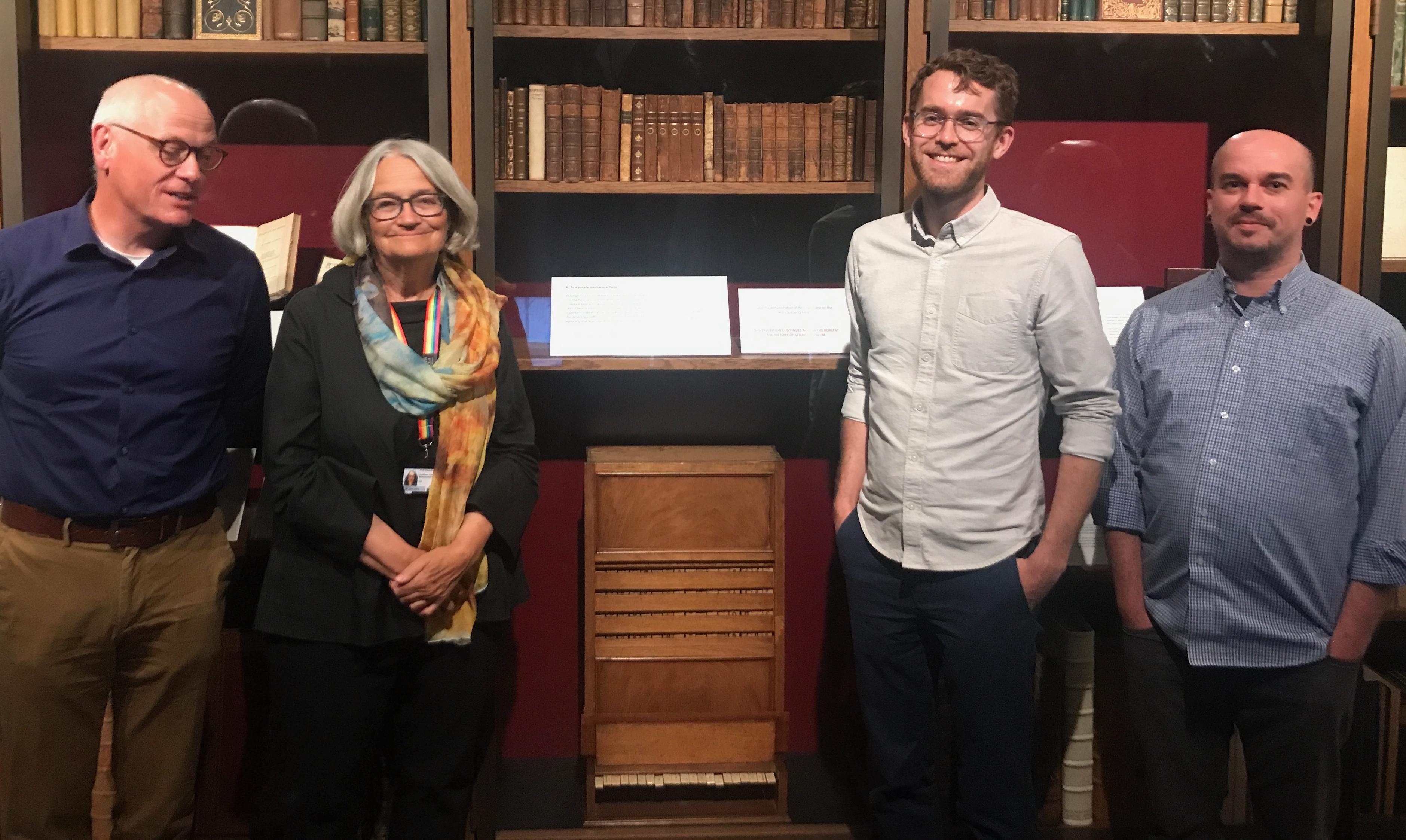Imagining AI
In September 2022, Oxford University's Bodleian Library, History of Science Museum, Faculty of History, and Mathematical Institute joined forces for the Imagining AI project.
Displays at Oxford's Bodleian Library and History of Science Museum placed artificial intelligence in its historical context, including the Bodleian's manuscripts of computer pioneer Ada Lovelace, pages from Mary Shelley's draft of "Frankenstein", and notes on computer poetry and draughts from Turing's collaborator Christopher Strachey. The History of Science Museum lent Stanley Jevons's remarkable mechanical “reasoning piano” from the 1860s, and an even earlier pocket logic calculator, as well as the earliest plans and prototypes of Charles Babbage's computers, and a copy of Ada Lovelace's so-called "first programme". The Imagining AI workshop showcased current scholarship, and a day of live encounters included a Cybernetic Ladybug.
AI is not all killer robots. It is far more dangerous. University of Oxford interview with Ursula Martin, September 2022
Report in the Oxford Mail Newspaper, September 2022
Oxfordba látogatott a szegedi robotkatica Origo News Channel, Budapest, September 2022
Imagining AI: A view from the archives, workshop 9th September 2022
The event was chaired by Professor Ursula Martin of Oxford Mathematics, and Professor Rob Iliffe of Oxford's Faculty of History, with speakers Dr Troy Astarte, Dr David Brock, Dr Kanta Dihal, Dr David Dunning, Professor Sharon Ruston and Dr Máté Szabó.
Dr Troy Astarte, Christopher Strachey and the “thinking” machine
Abstract: As the electronic calculator of the 1940s was replaced by the computer of the 1950s, and its flexibility was slowly revealed, comparisons to human cognition were immediate: Giant Brains and Faster than Thought. While most who worked with computers knew this was little but a metaphor, the question of whether machines could really think was a good route for exploring their capabilities. This was certainly the case for Christopher Strachey (1916–1975), with a Bloomsbury Group pedigree and protean curiosity. In 1950, he was a schoolmaster at Harrow, but managed to find himself time to experiment with computers. While most computer applications were still numerical, Strachey explored games, literature, and music, alongside systems to make programming easier. These various programs, some of them almost unique in their time, gave Strachey ample opportunity to ruminate on the question of computers and their ability to think—or lack thereof. Strachey's notes can be seen in the accompanying display.
Biography: Troy Kaighin Astarte is a teaching-focused lecturer in computer science at Swansea University. Educated in computing at Newcastle University, their research interest moved to the history of computing and computer science in particular. Building on research on the history of formal semantics of programming languages, and the history of concurrency, Troy is interested in questions about the role of computer science in shaping the world and vice-versa.
David C. Brock, Learning from AI’s Eternal Recurrence: Documenting the History of Expert Systems at the Computer History Museum
Abstract: The starting point for some of the Computer History Museum’s most recent work to document the history of artificial intelligence – through proactive collecting and oral histories – was recognizing a striking recurrence of both rhetoric and action in and around the artificial intelligence community. Increasingly over the past decade, researchers and commentators alike have hailed the combination of neural networks with large data sets and vast amounts of computing resources as a fundamental break with the past, with transformative sociopolitical implications for the near and far futures. The current CEO of Google recently went so far as to compare this to the first human control of fire. This same rhetoric – and the same flurry of action spanning commercialization and expanded government, especially military, interest and investment – can be found in the artificial intelligence community and commentators of the 1980s. Then, the past-shattering and future-altering combination was expert systems and advanced computing resources. In this talk, I will attempt to elucidate this recurrence, and will argue that one of the most celebrated achievements of the expert systems era – the military logistics system, DART, deployed by the US in the Gulf War of 1990-1991 – shows one possible future for our current moment.
Biography: David C. Brock is the Director of Curatorial Affairs, and the Director of the Software History Center, for the Computer History Museum in Mountain View, California. He is the co-author of Moore’s Law: The Life of Gordon Moore, Silicon Valley’s Quiet Revolutionary (Basic Books, 2015) and of Makers of the Microchip: A Documentary History of Fairchild Semiconductor (MIT Press, 2010).
Dr Kanta Dihal, How the world sees intelligent machines
Abstract: People have been imagining intelligent machines for millennia, in ways that vary greatly across cultures. Yet as artificial intelligence begins to fulfil its potential as a technology, spreading across the globe from its origins in 1950s America, many of these perspectives are marginalised. These stories, films, and visions matter: they are entangled in broader cultural attitudes and approaches to AI, reflecting or inspiring, embedding or disputing them. I will introduce such visions from across the globe, and what they can tell us now that AI is becoming a technological reality. I will draw out three themes: real and apparent differences between ‘Eastern’ and ‘Western’ portrayals of AI; visions of AI in communist states; and narratives of AI that explicitly aim to reject colonialist views of the technology.
Biography: Dr Kanta Dihal is a Senior Research Fellow at the Leverhulme Centre for the Future of Intelligence, University of Cambridge. Her research focuses on science narratives, particularly those that emerge from conflict. She currently manages the project ‘Desirable Digitalisation’, an international research collaboration that investigates intercultural perspectives on AI and fundamental rights and values. She is co-editor of the books AI Narratives (2020) and Imagining AI (2023) and has advised the World Economic Forum, the UK House of Lords, and the United Nations. She obtained her DPhil on the communication of quantum physics at Oxford in 2018.
Dr David E Dunning, "A Purely Mechanical Form”: William Stanley Jevons and the Materiality of Reasoning
Abstract: In the 1860s, philosopher of science and political economist William Stanley Jevons (1835–1882) designed a Logic Machine that, he claimed, reduced deduction “to a purely mechanical form.” As a box with a keyboard that mechanically spits out solutions to problems input by a user, this Logical Piano (as it is also known) readily evokes an embryonic idea of the digital computer when viewed with modern eyes. But perhaps what links this device most profoundly to today's computers is, ironically, the fact that it was not really about computing. While the digital computer’s better-known predecessors (such as Babbage’s engines) were concerned with numerical calculation, Jevons pursued a more philosophical goal, aiming to show that reasoning was a fundamentally material process. Like the notions of AI that emerged in the second of half of the twentieth century, his project envisioned a form of computing far more expansive than number crunching. In this talk I will situate Jevons’s machine in the context of early symbolic logic that produced it, focusing on the novel techniques of writing that he built on, and built into his device. I will use this history to understand the role of material processes such as instruction, display, and memory in the context of machines and the intelligence we imagine them to possess. The machine can be seen in the accompanying display.
Biography: David E. Dunning is a Lecturer in the Integrated Studies Program at the University of Pennsylvania and the 2022–23 IEEE Life Member History Fellow. He is a historian of science, technology, and mathematics, whose research focuses on the material and social dimensions of abstract knowledge. He co-developed the Imagining AI display while at the Mathematical Institute at the University of Oxford.
Professor Sharon Ruston, ‘Minds and Machines in Mary Shelley’s Frankenstein and beyond’
Abstract: The question of whether the Creature in Frankenstein is human is one that continues to be asked. Is he more like a man or a machine? In what ways is he like or like us? How much humanity does his maker, Victor Frankenstein, demonstrate in the novel? In this talk, I’ll consider how Mary Shelley’s novel discusses concepts such as the mind, morality, and the soul. I’ll look at other literary examples of apparently mindless states of being, such as suspended animation, somnambulism, and automata. I will also examine some unpublished manuscript notebook pages of the young Davy as he reflects on the dangerous idea that the mind might be thought of as merely a thinking machine. A page of Mary Shelley's manuscript can be seen in the accompanying display.
Biography: Professor Ruston is Chair in Romanticism at Lancaster University. She has published The Science of Life and Death in Frankenstein (2021), Creating Romanticism (2013), Romanticism: An Introduction (2010), and Shelley and Vitality (2005). She co-edited the Collected Letters of Sir Humphry Davy for Oxford University Press (2020). She currently leads an AHRC-funded project to transcribe all of the notebooks of Sir Humphry Davy (and urges everyone to help with this task!), details are here: Davy Notebooks Project | Zooniverse - People-powered research.
Dr Máté Szabó, Max Newman's Influence on Turing's Early Work
Abstract: In 1936 Turing published his groundbreaking article “On Computable Numbers”, in which he described a mathematical model of machine computation that later became known as Turing Machines. Turing became interested in the topic while attending Max Newman’s course on logic and foundations of mathematics a year earlier. In this talk I will take a look at little known early works of Newman and show how they ifluenced Turing’s seminal paper.
Biography: Máté Szabó is a historian and philosopher of computing and mathematical logic. He earned his PhD in "Logic, Computation and Methodology" from the Department of Philosophy at Carnegie Mellon University. He co-developed the Imagining AI display while at the Mathematical Institute at the University of Oxford, and is currently he is a lecturer at the University of Greenwich.
Imagining AI: Oxford's Bodleian Library, display, September 2022
Items and captions from the display
Preamble Today’s artificial intelligence is the latest chapter in a long story of humanity’s efforts to create self-acting machinery. With the dream of creating these machines comes the possibility – utopian, apocalyptic – that we might create artificial minds like our own.
Though we still speak of ‘computers’, we have long ceased to think of digital machines as primarily number crunchers. They don’t just calculate; they use logic, find patterns and follow algorithms. The technologies now called AI use computers to do this work at astonishing speed, making it easier than ever to imagine minds in our machines. But well before the digital age people saw even the earliest computers as interactive beings, programming them to write love letters and play games.
This long history shows that AI can be imagined in many ways. Behind this catchall term there must always be specific devices and techniques, made by specific human beings. Whether AI’s future resembles the darkest visions of science fiction depends not on artificial minds, but on the human minds aspiring to make them, and what we do with the machines we make.
Did Mary Shelley Invent the Technological Singularity? In Mary Shelley’s novel, Victor Frankenstein uses science to usurp the role of God the creator. He succeeds in making flesh breathe, but his creation lacks a divine soul. It is only an imitation of life. Annihilation follows as the created destroys its creator. How much do our modern fears around AI and robots draw on a nineteenth-century novel rooted in Judeo-Christian theology?
Displayed item, Mary Wollstonecraft Shelley, Pages from the draft of Frankenstein December 1816 (?) – April 1817, Bodleian MS. Abinger. c. 56, fol. 21r
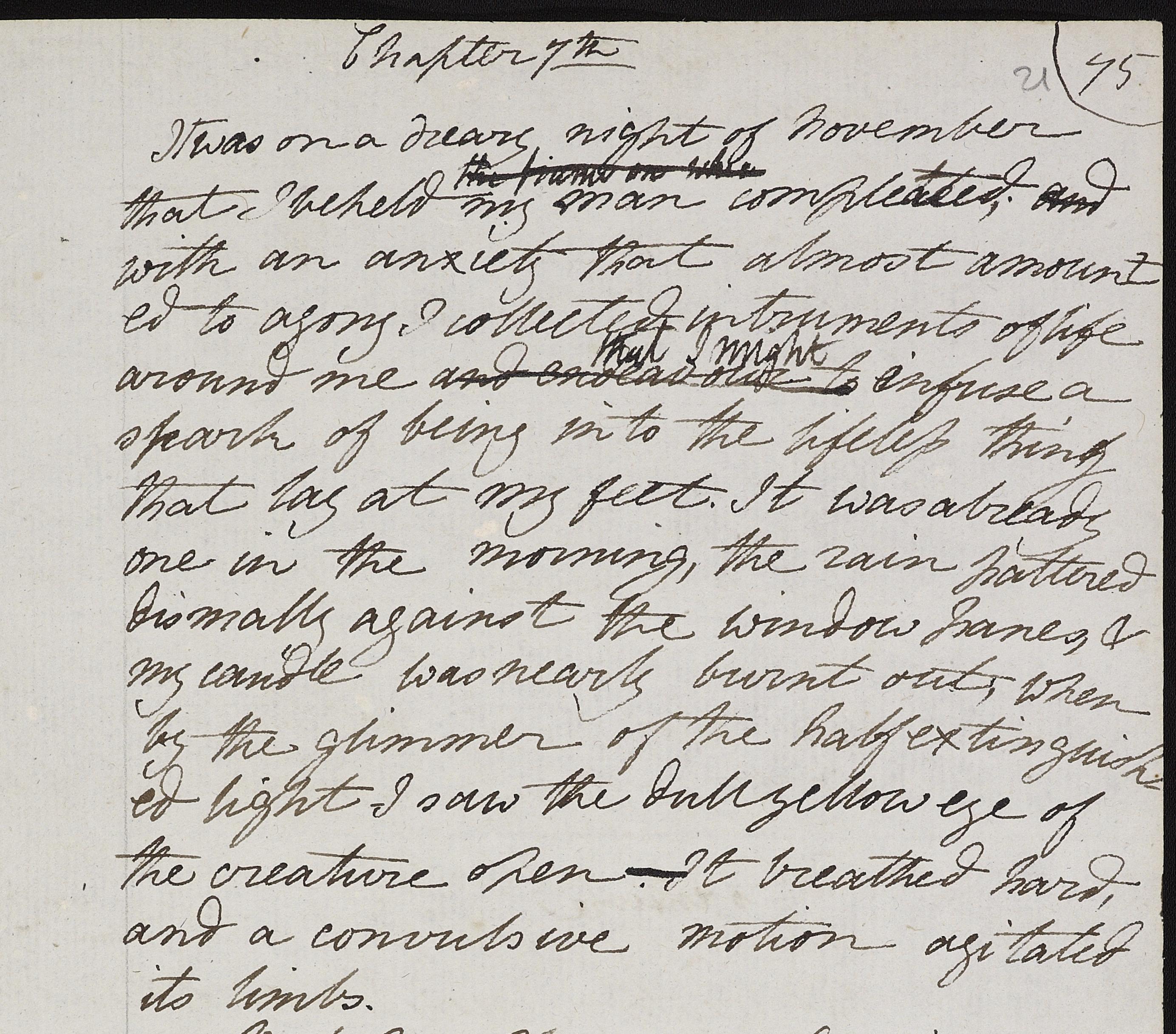
Further resource: Making machines: Mary Shelley and Ada Lovelace, Bodleian podcast by Sharon Ruston and Ursula Martin
The Fall and Rise of the Robots ... Frankenstein Lives! Tragically credulous, Butler’s Erewhonians believed a self- proclaimed prophet who foretold that machines would attain consciousness. Fearing obliteration they destroyed their machines, casting civilisation backwards.
Rossum’s universal robot factory grows artificial labourers. (‘Robota’ means ‘forced labour’ in Czech.) These robots are made of flesh but lack souls. They revolt, extinguishing humanity and taking over the earth. Frankenstein, Erewhon, and R.U.R. are past imaginings of artificial intelligence. Whether AI’s future resembles them is ours to determine.
Displayed item, pages from Erewhon, by Samuel Butler, with illustrations by Blair Hughes-Stanton, Gregynog Press, Montgomeryshire, 1932. Bodleian Broxb. 56.14
Displayed item, cover of R.U.R. (Rossums’ Universal Robots): A Play in Three Acts and an Epilogue by Karel Čapek and Paul Selver, London, 1923 Bodleian 388775 f.1
Data and Discovery Long before computers, Florence Nightingale analysed data by hand to improve medical care. Her novel diagram demonstrated that infection was the major cause of death in a British army campaign.
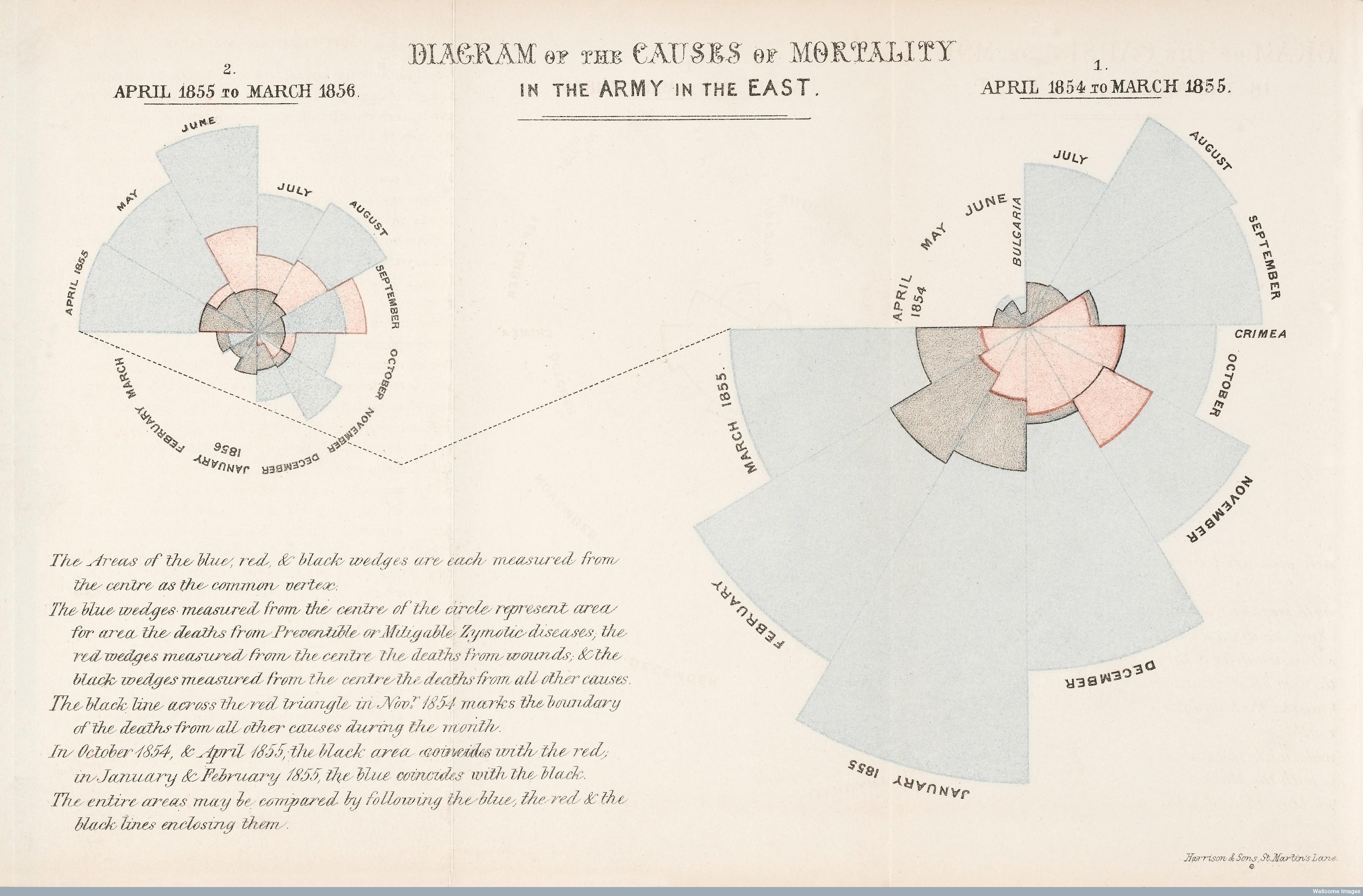
Charles Babbage never built his most ambitious invention, the Analytical Engine. It could in principle have done the same things as a modern computer, but very slowly. Ada Lovelace speculated that it could compose music, or make original scientific discoveries.
Displayed item, "Rose Diagram" by Florence Nightingale, frontispiece of "England and Her Soldiers", by Harriet Martineau, London, 1859. Bodleian 226 b..42
Displayed item, frontispiece of "Passages from the life of a philosopher" by Charles Babbage, London, 1864. Bodleian 1981 d.36
Algorithms and the Brain Can you walk around the islands and cross each bridge just once? Lovelace and Babbage have found the answer: ‘If there are an odd No of Bridges, if you do not begin you must end in it ...’ Modern AI uses more sophisticated algorithms to find patterns in data.
What if mathematics could explain the brain? Ada Lovelace writes to a friend: ‘It does not appear to me that cerebral matter need to be more unmanageable to the mathematicians than sidereal & planetary matter and movements... I hope to bequeath to the generations a Calculus of the Nervous System.’
Displayed item, Manuscript in the hands of Charles Babbage and Ada Lovelace, including drawings of the "Bridges of Konigsberg" problem, c. 1840. Bodleian Dep. Lovelace Byron 170, fols 176v–177r
Displayed item, Letter from Ada Lovelace to Woronzow Grieg, 15 November 1844. Bodleian MS. Dep. c. 364, fol. 255r
To a purely mechanical form Victorian economist William Stanley Jevons designed this machine, also sometimes known as his Logic Piano, to reduce logical thinking ‘to a purely mechanical form.’ There is a long history of inventions that aimed to perform mathematical calculations automatically. This device was different in that it mechanized a kind of reasoning that was logical rather than numerical.
Displayed item, Logic Machine designed by W. Stanley Jevons and made in Manchester, 1869. Oxford History of Science Museum Inv. 18230
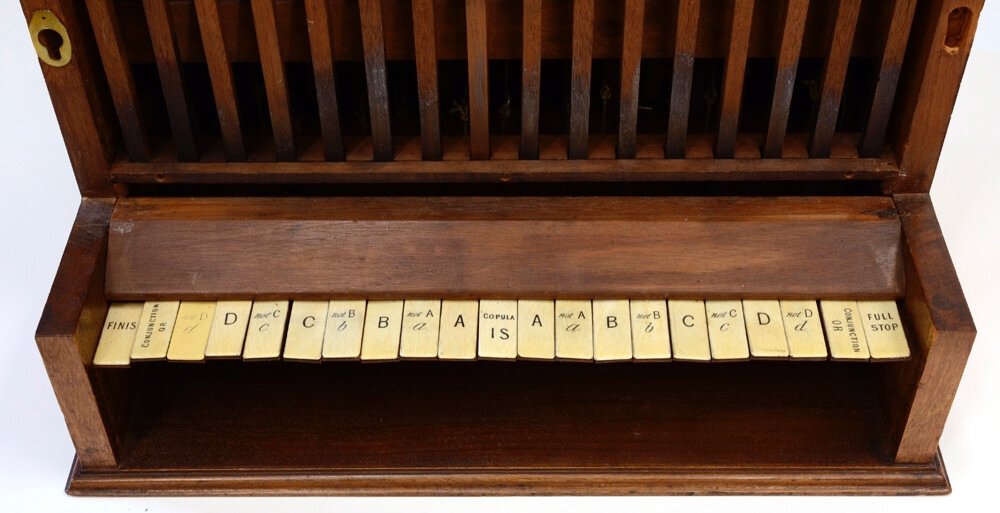
Further resources:
‘By means of Logic only’ Logic isn’t always high tech. These diagrams belong to a late medieval commentary on the work of Catalan theologian Ramon Llull. Aiming to defend Christianity, Llull developed elaborate diagrams that he claimed could mechanically demonstrate religious truths.
The inventor Charles Stanhope insisted that his successes were made by ‘Logic applied to certain Facts, mechanical, chemical, physical, &c. & by means of Logic only.’ This device demonstrated his logical system. He claimed it could ‘ascend ... from the first definitions to the higher and most sublime speculations of Newton.’
Displayed item, illustrations from Johannes Bolons of Barcelona, Commentary on Raymond Lull, Ars generalis et ultima, 1438. Bodleian MS. Canon. misc. 26
Displayed item, ‘Logic Demonstrator’, designed by Earl Stanhope and made at his workshops at Chevening Castle, Kent, c. 1810 Oxford History of Science Museum Inv. 45952
A self-acting algebraic notation The mathematician George Boole invented a system for representing logic with mathematical symbols. His wife, Mary Everest Boole, wrote, ‘My husband carried out Babbage’s idea by means, not of a machine, but of a self- acting algebraic notation.’
Jonathan Swift’s fictional traveller Gulliver encounters a professor who has built a machine that can automatically write a book on any topic ‘without the least assistance from genius or study’. This fantastical device is thought to be a satire of Ramon Llull’s techniques (item 9).
Displayed item, pages from The Mathematical Analysis of Logic by George Boole, Cambridge 1847. Bodleian 47.43
Displayed item, pages from Gulliver’s Travels, or, Travels into Several Remote Nations of the World: In Four Parts by Jonathan Swift, London, 1726. Bodleian Vet. A4 e.2218
The Computer Learns to Love In the early 1950s, Christopher Strachey created a Love Letter-generating program. While it displays ‘anthropomorphic behaviour’, he wrote, it does not think – it merely uses ‘childishly simple’ tricks. The letters consist of two types of sentences with words chosen randomly from a word-bank based on Roget’s Thesaurus, lending the letters a rather Victorian tone.
Displayed item, working papers from Papers and correspondence of Christopher Strachey, 1952. Bodleian MS. Eng. misc. b. 259, C34
All Fun & Games Strachey also developed a program that played ‘quite a tolerable game’ of draughts. It was able to ‘look ahead’ to the player’s next three moves. Users of the Manchester University’s computer could play the game interactively on a cathode-ray tube display – one of the world’s first video games. While games are often considered a good way to test AI, Strachey stressed that his programme could neither think nor learn.
Displayed item, working papers from Papers and correspondence of Christopher Strachey, 1952. Bodleian MS. Eng. misc. b. 258, C30
Displayed item, working papers from Papers and correspondence of Christopher Strachey, 1952. Bodleian MS. Eng. misc. b. 258, C32
The Imagining AI display at Oxford's Weston Library in September 2022 was curated by Professor Ursula Martin, Dr David Dunning and Dr Máté Szabó, all of Oxford Mathematics, and Colin Williams of Oxford's Faculty of History, and realised by the Bodleian Exhibitions Team led by Sallyanne Gilchrist.
Imagining AI: Oxford's History of Science Museum, display September 2022
Items and captions from the display: images at History of Science Museum: Imagining AI
Charles Babbage (1791-1871) was a mathematician, economist and engineer. He had a very practical interest in machinery and produced detailed designs for several computing engines. The most ambitious was his “Analytical Engine”, which in principle could do the same things as a modern computer, but very slowly. Babbage also thought deeply about the abstract principles of computing, and the power and limits of what computers might be able to do. Because of a lack of money and the vast scale and complexity of his ideas, only small models of his machines were produced in his lifetime.
“A steam-engine could be contrived…” Babbage claimed that the idea of building an “engine” to do tedious calculations first occurred to him in a conversation with the astronomer William Herschel
In the course of our conversations on this subject it was suggested by one of us- in a manner which certainly at the time was not altogether serious- that it would be extremely convenient if a steam-engine could be contrived to execute calculations for us; to which it was replied that such a thing was quite possible, a sentiment in which we both entirely concurred, and here the conversation terminated.
(punctuation added)
Displayed item, page from manuscript by Charles Babbage, n.d. Oxford History of Science Museum MS Buxton 7.34
Engine for the table of differences These are thought to be some of Babbage’s earliest plans for his “engines”. He thought carefully about practical details and drew on many existing technologies. Here he explains the design of a printer, drawing on ideas from music printing with “music-plate-composition-metal”.
Displayed item, page from manuscript by Charles Babbage, 1822, Oxford History of Science Museum MS Buxton 9.2 1r, 2r
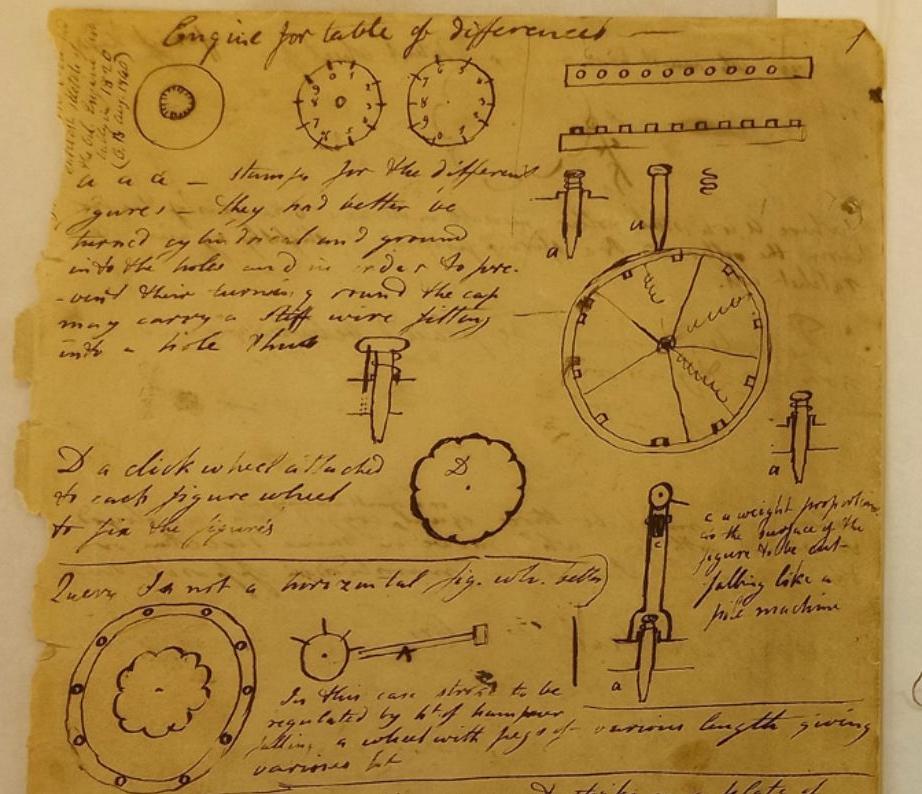
List of operations. Babbage was interested in the abstract principles of what computers could do. He believed that a computer that could carry out the operations listed here could, in principle, compute anything that could be computed. Alan Turing made this idea precise around 100 years later. These are the basic operations of modern computers.
Displayed item, page from manuscript by Charles Babbage, circa 1837, Oxford History of Science Museum, MS Buxton 7.6
The first programme? This diagram appears in Ada Lovelace’s article on Babbage’s unbuilt Analytical Engine. Each line shows a step in the calculation of a formula. The words “here follows a repetition…” indicate what we would now call a loop. Modern programming combines ordinary language, logic and mathematics to precisely and unambiguously tell computers what to do.
Displayed item, pages from Notes on the Analytical Engine, 1843, MS Buxton 4.15
The Imagining AI display at Oxford's History of Science Museum in September 2022 was curated by Professor Ursula Martin and Dr Máté Szabó, and realised by Lucy Blaxland of the History of Science Museum.
Imagining AI live encounters, 10th September 2022
As part of Oxford's Open Doors programme, demonstrations and live encounters in Oxford's Bodleian Library, coordinated by Helen Cook of the Library Education Team, included:
- A demonstration of a modern 3-D printed Difference Engine in action, inspired by Charles Babbage's work, courtesy of Royal Holloway, University of London. More here
- A cybernetic ladybug that responds to light, sound, and interaction. This model, provided courtesy of the John von Neumann Computer Society, is based on the Hungarian original from the late 1950s. More here
- Students from Cheney School exhibited artwork and creative writing responding to artificial intelligence in our lives today and in the future. Ai-Da, the world’s first ultra-realistic robot artist, was hosted by Cheney School’s Rumble Museum Council students for a Q&A and live art session More here
- cs4fn magazine Cunning Computational Contraptions: Issue 28 of the cs4fn magazine from Queen Mary University of London looks at some of the machines contrived in earlier times to support dreams of artificial intelligence.
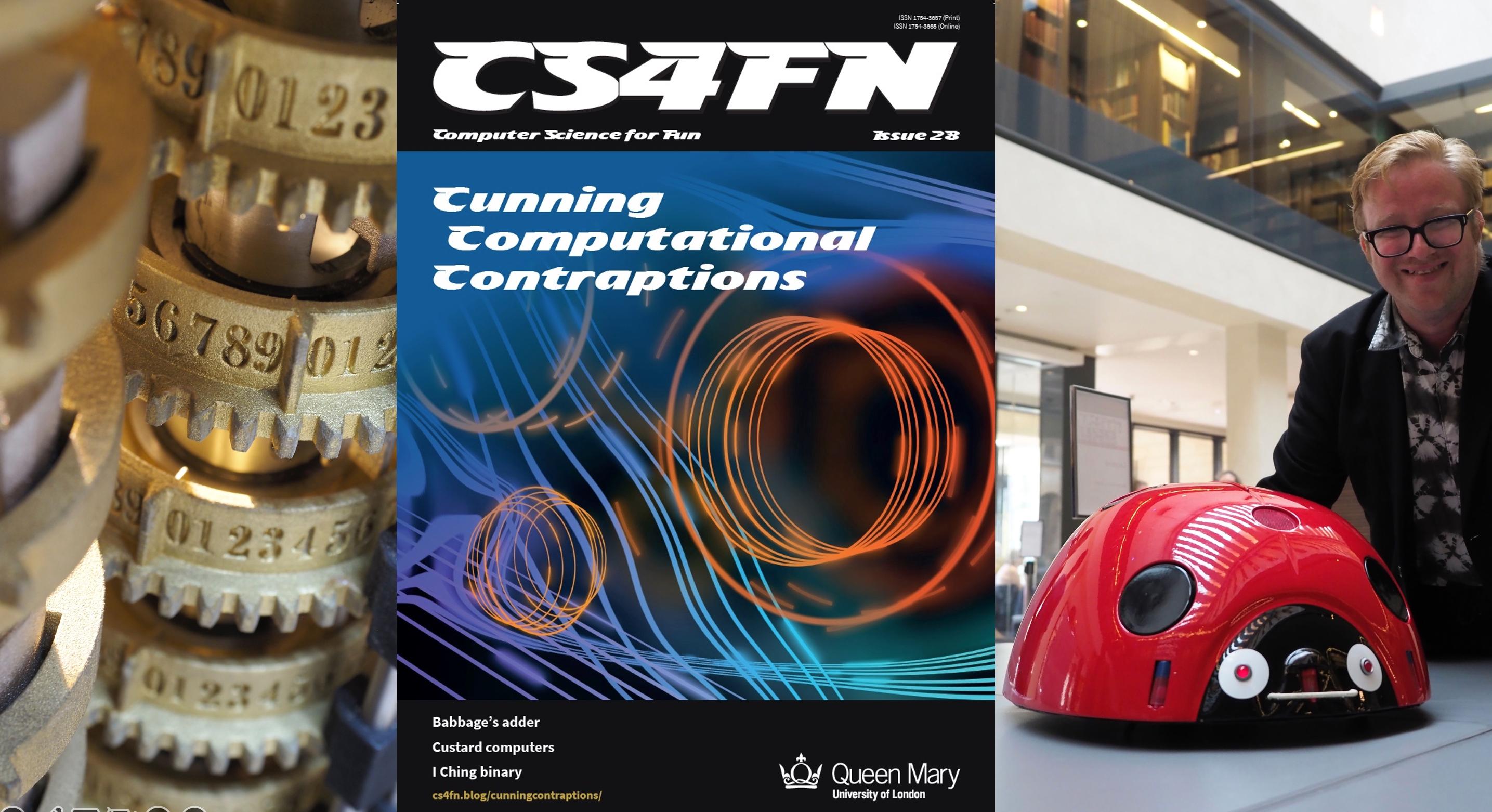
Imagining AI was part of a long term project on the cultures of mathematics and computing, with funding provided by UKRI under grant EP/R03169X/1 held by Professor Ursula Martin. Plans for a much more substantial display, and other activities, had to be dropped because of the pandemic. Additional support was provided by Oxford's Faculty of History and Mathematical Institute; Wadham College Oxford; the John von Neumann Computer Society; and the HAPOC Commission. We thank colleagues at Oxford's Bodleian Library and History of Science Museum for their enthusiastic support. Photo credits Bodleian Library, History of Science Museum, Troy Astarte and Ursula Martin.
